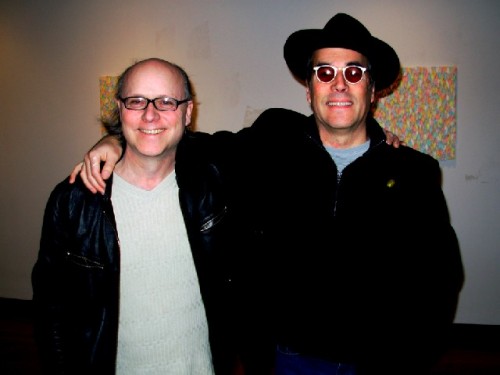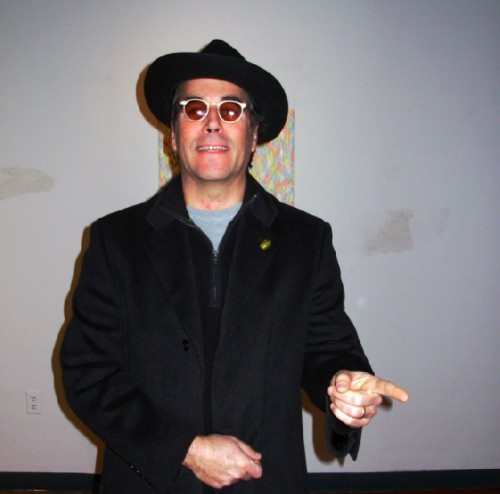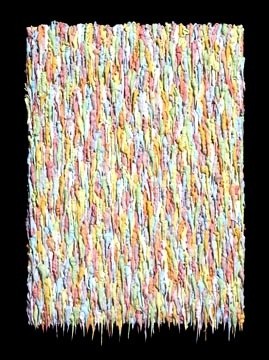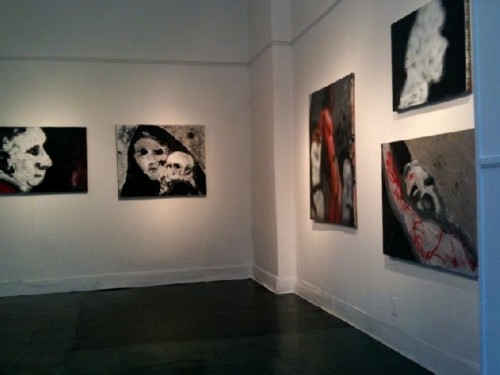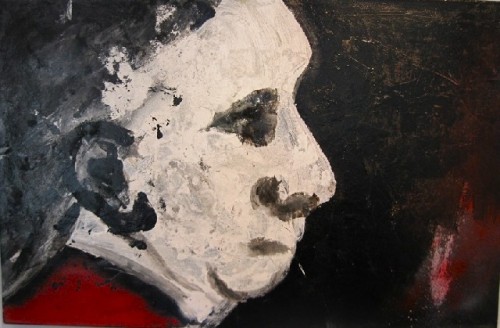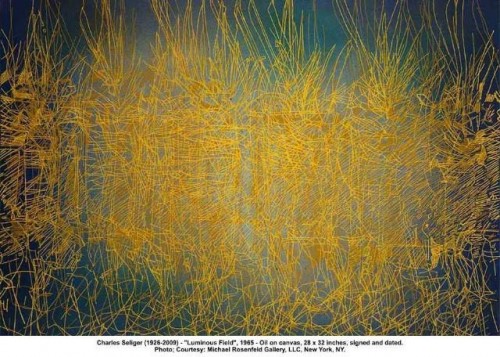Rethinking The Severed Ear
Exhibition Curated by Addison Parks a Decade Ago
By: Martin Mugar - Jul 08, 2010
More than ten years ago the artist Addison Parks curated the group show “Severed Ear” at Crieger Dane Gallery on Newbury St, Boston. In retrospect it was one of the most important shows in Boston during that decade.The ideas embodied in the show are still alive at the Bow Street Gallery run by Addison’s wife Stacey Parks.
Now as then Parks sees the explorations of abstract expressionism as only the start of the making of a kind of universal language to be used to open up the lived inner space of the artist.
Just as actors learn to control the movements of the face and voice to reveal what waves of emotion and thoughts are moving within, all the stuff that is hidden without which we would just be automatons walking through our earthly roles, so the gestures and marks that became the hallmark of abstract expression allowed those progenitors such as Gorky, deKooning and Pollock to say things that painting had never expressed before. It evokes the landscape of consciousness, of memory, of the emotions of being alive: love ,hope, anger, yearning for truth.
The subtitle of the show was “The Poetry of Abstraction”. The word poetry adds on top of abstraction notions of essences, intense moments in time where things come together or fall apart, but above all a record of that event as event. And of course the severed ear is Van Gogh’s who transformed, more than anyone, painting into a vehicle for revealing our unconscious and physical connections to the universe. He was the father of any kind of painting that goes beyond cool surfaces.
Whereas the first generation of abstract expressionists created a language for the most part of self assertion, raw power, often a primal scream begging for recognition, Addison’s show included contemporary practitioners of abstract expressionism like Bill Jensen who use the marks and gestures of paint as a miner’s tool to dig within to uncover connections and bonds with nature and the strange entities that are so other to the role that the public self assumes.
It is not so much the pushing out to grasp the larger and larger vistas as we see in deKooning and Pollock but a turning inward toward uncanny shapes and symbols that surprise us in the psyche.
Another show member Charles Seliger painted some primordial sea upon which our being floats. Joan Snyder revealed a difficult and pained inner realm where psychic disturbance has never been more vividly displayed. Richard Tuttle brings the mark and gesture back from the metaphysical excesses of deKooning and Pollock to make marks that don’t add up to large structures but stay close to primordial grunts and groans that sit at the base of all communication.
I once said on Addison’s blog that his work reminded me of the makeshift weapons prisoners construct in order to escape from their cells. Crude but effective. I wonder if anyone has seen connections between his work and what Richard Rorty, the pragmatist philosopher has to say about post metaphysical language.
Intentionally or not pure Abstraction was absent from the show.
But its absence makes sense .In its more advanced forms it has interestingly enough suppressed emotion. From Al Held's “Big N” to Ellsworth Kelly’s primary color panels and LeWitt’s rectilinear patterns, the flat colors and lines are drained of any emotional depth except maybe a will to do away with emotion.
As Addison mentioned in response to a recent show at the Betty Cuningham Gallery that included works and statements by Al Held, the statement of intent by Held dating from the ‘60s is a list of what he did not want to do in his painting rather than what he wanted to do. A will not to say yes, a yes that might embrace. It always reminds me of Sgt Friday from Dragnet who would ask his witnesses in a monotone devoid of feeling ”The Facts ma’m nothing but the facts.”
As I get into this discussion of “The Severed Ear” and what is clearly its opposition to the Big No, I realize that I should address the other big No, the whole realm of art that issued from Duchamp and now almost totally dominates the art world and art education a hundred years after its inception.
Actually Held and Kelley maintained in an incredibly reduced form the language of perception that Duchamp wanted to undermine. For him the flat surface that reflected reality was a dead horse and his minions have been beating that horse for quite some time. On the one hand you have the artists who maintain the cool surfaces of perception and on the other hand we have to be reminded by the Duchampians that the metaphysical power of the canvas is forever deconstructed.
All these negative alternatives. Barely any feelings allowed by the abstractionists, no ground upon which to say it for the Duchampians.
I recently saw the work of a recent Yale Grad who had gone to AIB where I taught for many years. I never had the chance to have her as a student since I was let go a year after she started studying there. The rumors were that she was incredibly talented. Last Fall I had the opportunity to meet her.
We went on line and looked at her website. It was clear from what I saw that Yale had not really changed from when I was a grad student there in the ‘70s.She has absorbed the icy abstraction of one faction of the faculty and the figuration of the other faction (although the latter faction may be her training under Sigmund Abeles).
Whereas for me as a student there in the ‘70s under Held and Bailey their conflict formed a dialectic that I learned over time to resolve but only with great difficulty. For her it was some sort of ironic game where both schools were placed side by side inertly and never hinted at any sort of dialogue. They were both divested of their power. They had been subsumed by Duchampian irony and voided of any impact on the viewer.
The origin of abstraction in figuration was never addressed, but more worrisome was the smugness of the assumption that nothing more had to be done. She seemed incapable of putting a value on either mode of painting. She could not weigh each manner of painting to feel its heft.
I suspect that this resolution is being taught by the faculty and judging from the decisions of who got into the recent Danforth museum show curated by Helen Molesworth of the ICA Boston who taught at Yale: vacuity has become an aesthetic.
At Yale the student does not come up with a solution that arrives from much struggle and thought over origins and meanings but is offered up a facile escape. An image is an image and nothing lies underneath it.
Hey it could be that they are leaping out of the language of the past into a sort of enlightened stat of being where nothing weighs heavily any more on the psyche ir there is even that left.A brave new world where there is no sorrow or melancholy. I suspect that we are witnessing the strange merger of bureaucrat and artist.
It is the tragic consequence of the move of art into academia. The Paper pusher and bean counter who have always formed the infrastructure of academia in which the artist work and lives finally subsuming and taming the wild anarchic drives of the artist spirit.
Needless to say her painting is being received with some critical acclaim.
Addison Park, whose painting was part of the “Severed Ear” show and occasionally shows his painting at Bow, functions on a level that leaves all the stale dogma behind. He in fact seems to be preternaturally incapable of buying into the dichotomies that constrain the way artists think especially those who are products of the art schools. His work of the late nineties to mid 2000 was imbued with patience and waiting. A reader of Emerson and Thoreau he has embraced the attitude of Emerson who thought that art should adopt the pace of nature, which is patience.
Bars of color hid wild organic shapes as though he were expressing restraint in embracing the powers of nature. It was also homage to abstraction, the language of color and shape that he felt compelled to honor. This kind of gratitude for what the tradition gives us is rare in contemporary artists. But whatever his intentions he couldn’t keep the organic suppressed. Sometimes the organic shapes moved in front at other times they seemed to merge together with the bars but the dialectic never resolved itself.
When those shapes finally broke out from the bars he filled a whole gallery with petals or leaf shapes .It could have been misinterpreted as self- assertion but it was the assertion of nature naturing, his force is nature’s force.
But the story does not end here; the leaves had to leaf to be themselves. I had said in an essay about his work in the ‘90s that it is not about self-expression it is about letting things be. Most recently the lobe of a leaf in the way he manipulated the lines started to flutter as though by the wind. My first thought on seeing this affect were the vibrating leaves on the tree outside of St Francis’ cave in Giovanni Bellini’s painting in the Frick or the rays of the divine in Fran Angelico’s Annunciation in Florence.
Huh! Fra Angelico, Bellini!! A gallery that shows art that elicits this sort of reference! Keep your eyes focused on Bow Street. Whereas the big art institutions in Boston are dominated by current trends and have pulled up their ladders lest anyone but the dancing bears of recent MFA vintage join, in Cambridge a gallery shows work by artists scouring “the rag and bone shop of the heart”.
A new gallery member at Bow is Larry Deyab whose new paintings currently on exhibit are a case in point. They are not ideological: no manifestos of what art is supposed to be. Nothing to prove, no game to play that is exclusive to an elite, no ladders to pull up behind to keep the unlettered from joining in.
If anything his work is emblematic of Yeat’s ladder that goes the other way down from the images of “pure mind”into “the foul rag and bone shop of the heart”. The subject is the horror of the constant conflict in the Middle East. A world of blind id, one tribe against another. People so wrapped up in their own stink that they are blinded from seeing the humanity of the other.
In Deyab’s work, it seems to boil up from the depths of the psyche: anger, horror and like Tuttle he uses what’s at hand: the spray paint can the tool of the graffiti artists. Graffiti art was praised as a societal bottom up phenomena. Its emotional breadth ranged from celebration to in your face rage as it defaced the mechanized golem of modern life that the underclass felt alienated from. It was bold and aggressive. So it makes sense that he should use this grafitti style and technique to represent the cause of the underclasses of the middle east..
Larry a Christian Arab-American descended from Syrian immigrants brings misericordia to the subject. He is not a hipster; these paintings aren’t a cool jazz riff on the human condition; these paintings have the terror of Goya’s black period but benefit historically from being painted after abstract expressionism which allows him to use the potent gestures of paint liberated by deKooning and Gorky.
It is work in agreement with Addison’s vision of art as being beyond ideology and also shares Addison’s love of painting. We see it all: Turner, Goya, Pollock, street artists of the ‘70s.A sophisticated use of negative space with which he defines the chasm between the characters in his scenes.
The scenes are drawn from media; movies and print for how else could you get a handle on what happens in the Middle East unless you lived there. Whereas the photographic image is used to cool off violent subject matter in Warhol, Deyab breaks down the distanciating affect of the photograph. The Warholian alienation theme of commodification seems silly in the face of Middle East chaos.
Imagine the darkness of film noir, which describes life on the margins of the rationalized and enlightened West transposed to whole populations of the Middle East. The characters often have no eyes and their hands seem leperous. There are no shared gazes no possibility of embrace. These are paintings of no exit, and endgame.
Although one can imagine a scenario where politically one could end this madness, in the meantime the experience of the large sectors of the Middle East is one of horror. So they wait lurching from one horror to the next.
I remember Robert Longo lecturing at UNC-Greensboro to the gap-mouthed docents hungry to be fed pseudo profundities by a NY hipster. He ended his lecture with the statement that just before he dies his mind will speak out”Eat at Burger King”.Horrors!! his mind has been colonized by mass media. Is America superficial or what ?
What about a whole people that is colonized and trapped and denied the possibility of asserting their identity. Only Deyab has the guts to do it. His art heroes are not of this time and place. Think the revolutionary Delacroix with his Massacre at Chios or the angry Goya of the last years.
My first lecture teaching Western Civilization at UNC-G showed slides of men on horse back through history,; Assyrian, Greek, Roman, Italian, American.
I told my freshmen students who only cared about basketball thatl all civilizations were built on the back of an exploited people. The men on horse back were symbols of that dominant power. There were few images of the victims until Delacroix and Goya and now we have Deyab.

